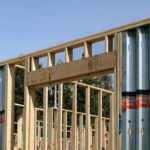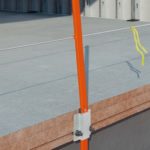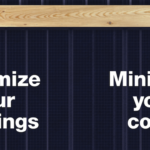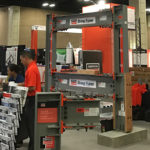In this post, we follow up on our May 2 webinar, Seismic Resilience and Risk Assessment of the Yield-Link® Connection for Steel Construction, by answering some of the interesting questions raised by the attendees.
During the webinar, we discussed how to achieve seismic resiliency in steel construction with our Yield-Link connection for steel special moment frames and the Seismic Performance Prediction Program (SP3) by Haselton Baker Risk Group. In case you weren’t able to join our discussion, you can watch the on-demand webinar and earn PDHs and CEUs here.
As with our previous webinars, we ended with a Q&A session for the attendees. Jeff Ellis, our Director of Codes and Compliance, and Curt Haselton and Jared Debock, from Haselton Baker Risk Group, answered as many questions as they could in the time allowed. Now we are back to recap some of the more commonly asked questions and their answers. If you’re interested in seeing the full list of questions, click here.
YIELD-LINK® CONNECTION
Is it easy to replace the top-flange Yield-Link if the composite deck is attached to the moment frame beam?
The local top of concrete would need to be removed to access the Yield-Link. Simpson Strong-Tie has prepared and can provide standard details to accommodate removing the slab over the connection. Please contact Simpson Strong-Tie Engineering Services for assistance.
Is there an estimate to how much the construction costs are increased with the use of the Yield-Link connections?
Costs are generally similar to those for other structural steel connections, in our experience, and in some cases smaller, because beams using Yield-Link connections may be designed without lateral bracing, and they don’t require field welding.
How is the cost of this system handled? Who fabricates the connection detail pieces? Is there a licensing fee, etc.?
The Yield-Link connection is supplied to approved structural steel fabricators. The Designer would use the structural software (i.e., SAP, ETABS, etc.) plugins to determine the appropriate design for a special moment frame with Yield-Links for a given project; the Designer would specify those in the construction documents; the structural steel fabricator would develop shop drawings for the Designer to review; Simpson Strong-Tie would provide the Yield-Link connections to the fabricator; and then the fabricator would provide the special moment frame members and Yield-Link connections to the contractor.
Can the Yield-Link connection be stacked in multistory structural steel construction?
The Yield-Link connections may be used in multibay and multistory applications. See AISC 358 and https://www.strongtie.com/solutions/mid-rise-steel/yield-link.
When you’re using the Yield-Link connection, does the SMF members need to be from Simpson Strong-Tie, or can other column and beam sizes meeting SMF requirements be used? Who designs the Yield-Link connections? How do we spec this out, detail it or indicate it in design drawings?
We sell the link kits directly to the fabricator/erector. The beams and columns are called out by the specifying engineer, as with any other SMF. The design procedure for the Yield-Link is provided in AISC 358-16 Chapter 12. We have plugins for SAP/Etabs and spreadsheets that can be imported into RAM and Risa; we will be integrated with these two programs early next year. There are also Revit and Tekla plugins available on our website. All these plugins are free of charge to download.
Is the Yield-Link connection part of the protected zone?
The protected zone follows the bolted area of the links and 1½” out from the shear tab web connection. There is no protected zone in the web between the link connections.
Is there a maximum moment demand that the Yield-Link is applicable to? In other words, has testing been done to evaluate performance under very large moment demands?
The Simpson Strong-Tie steel special moment frame Yield-Link is recognized in International Code Council Evaluation Service Report 2802 (ICC-ES ESR-2802), and it limits the beam depth to a maximum of W36 for rolled shapes and built-up members and limits the column depth to W36 for rolled shapes and built-up members. The maximum moment the connection is rated for would be associated with our largest Yield-Link connections (yield core of 6″ x 1″) placed on W36 sections. For, say, a W36x210 connection, the centers of the yield cores are separated by 37.7″, yielding a nominal yield moment of (6 in.2)(50ksi)(37.7 in.) = 11,310 kip-in.
Is the Yield-Link stiffer or softer than RBS when the yielding moments are the same?
If we compare a Yield-Link/beam combination with a given plastic section modulus (yield moment) to a W section with the same plastic section modulus, the corresponding moment of inertia (stiffness) of the Yield-Link connection will be greater than the W section’s moment of inertia.
SP3 SOFTWARE, SEISMIC RESILIENCE
Is there a sense of how much additional increase design work would be involved?
There is a wide range of effort possible, and it is up to the engineer and owner as to what is desired. With minimal effort (a few hours), the SP3-RiskModel could be used to arrive at simple upfront design decisions (e.g., system selection; design for lower drift limit) to make a building more resilient . For a more comprehensive resilient design, the SP3-Design platform can be used to get down to the level of detail of nonstructural component design (e.g., ensuring that an essential facility will remain functional after the earthquake).
Have you seen willingness on the insurance industry’s part to offer premium reductions for properties that were designed to limit damage?
This development isn’t yet widespread but seems to be emerging. We had our first insurer start using SP3 in 2018 to underwrite high-value properties.
How much does the SP3 subscription cost? Is it on a per-project basis?
Annual licenses for SP3-Design are $6,000 and $8,500. These include one network seat, unlimited user accounts in the company, and five and 12 buildings per year, respectively. The SP3-RiskModel licenses are similar per project, but SP3-RiskModel clients typically purchase licenses for higher volumes of projects.
Do these comparison charts for RBS and Yield-Link use the same column and beam section sizes?
No. The comparisons are based on complete structural designs using both design approaches. This results in the Yield-Link frames having larger columns, based on the design methods used when designing those frames.
How sure are we that the SP3 results are accurate? How are the program results validated/confirmed?
All risk assessments are estimates, since earthquakes and their results have a lot of uncertainty. Given this reality, FEMA P-58 provided the most documented and well-reasoned risk assessment method currently available (built up from a lot of experimental test data and research). For validation, broad comparisons have been made with past generic judgment/experience-based methods (e.g., Hazus), and the comparisons have shown that the answers agree well on average, but show that P-58 results vary by ~x2 for individual buildings because P-58 is building-specific and Hazus is not building-specific (it is for broad categories of buildings only).
Do you provide training on how to use the SP3 program? If so, is this part of the cost of the program or an add-on? For tech help, do you have engineers on board providing assistance?
Training is included in the license costs and is an important part of what we do in supporting SP3. We have a staff of licensed engineers who conduct both the training and the technical support.
When structural responses are input from, say, response spectrum results or by using the built-in SP3, how is the variability of structural responses included in the probabilistic analysis? In other words, when only one set of response data is input, how is Monte Carlo conducted?
The variability in responses is included through indicating that variability and through a detailed model in SP3 that correlates the various responses appropriately as the Monte Carlo similar is run. In short, variability is fully included even if the provided responses are only mean values.







